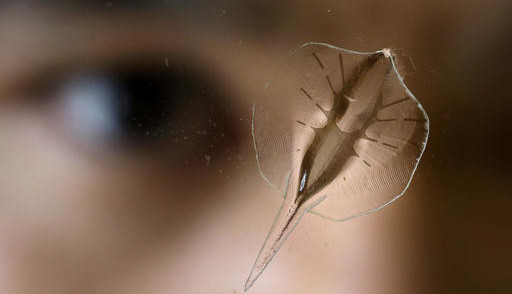Stingray from a rat's heart
August 22, 2016
on
on

What you see in the accompanying photo is an artificial ray (like a stingray) totally created in the laboratory, which swims with a wave motion. It’s a robot, the size of a small coin, which swims towards the light. Nothing new in that at first sight, light seeking robots have been around for decades..
You’ll change your mind when you know that the muscle which moves the silicon fins of this small translucent creature is composed of… heart cells from a rat.
This bio hybrid device conceived by researchers of the department of biopathology at Harvard University in Cambridge, Mass. USA: is it a robot? It swims, controlled remotely by pulses of blue light. These cause contraction of tissue obtained from the heart of a rat; the cells have been genetically modified to respond to specific pulses of light.
The tissue contraction causes a small deformation of the golden skeleton of the creature and thus a downward movement of the fin. The skeleton then regains its normal shape and in doing so drives the fin upward. The repetition of these two movements results in an undulatory swimming movement.
This interdisciplinary project, launched to clarify some mysteries of the human heart, is just a step on the long road leading one day to the manufacture of an artificial heart. It was very costly and aroused a lot of interest from various other disciplines. This is not the team’s first trial; in 2012 they created a type of jellyfish, always searching for a better understanding of the workings of the heart pump.
You’ll change your mind when you know that the muscle which moves the silicon fins of this small translucent creature is composed of… heart cells from a rat.
This bio hybrid device conceived by researchers of the department of biopathology at Harvard University in Cambridge, Mass. USA: is it a robot? It swims, controlled remotely by pulses of blue light. These cause contraction of tissue obtained from the heart of a rat; the cells have been genetically modified to respond to specific pulses of light.
The tissue contraction causes a small deformation of the golden skeleton of the creature and thus a downward movement of the fin. The skeleton then regains its normal shape and in doing so drives the fin upward. The repetition of these two movements results in an undulatory swimming movement.
This interdisciplinary project, launched to clarify some mysteries of the human heart, is just a step on the long road leading one day to the manufacture of an artificial heart. It was very costly and aroused a lot of interest from various other disciplines. This is not the team’s first trial; in 2012 they created a type of jellyfish, always searching for a better understanding of the workings of the heart pump.
Read full article
Hide full article


Discussion (0 comments)